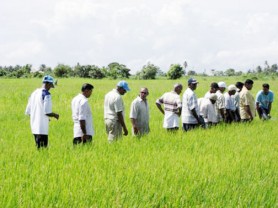-2010 first crop exports earn US$68.5M
Guyana’s rice industry may be set to surpass sugar as the country’s principal money earner from agriculture, according to a recent review of the sector’s performance done by the Ministry of Agriculture.

The official review of the current state of the sector concludes that it continues to hold its own despite what the Ministry says are “several challenges.” Statistics produced by the Ministry show that the rice sector—which accounted for approximately 3.3% of the country’s Gross Domestic Product (GDP)—by last year upped its export earnings by 147% over the past five years.
The statistical review of the performance of the industry also points to a 7.2% increase in the total area under cultivation and an increase of 9.8% in harvested area between January and June this year when compared with the same period last year. The Agriculture Ministry says that the expansion of area under cultivation and increased harvesting resulted in an overall 4.5% increase in production. Last year’s paddy first crop yielded 258,873 metric tonnes of paddy compared with 247,492 metric tonnes during the same period the previous year while actual rice production jumped from 160,670 metric tonnes for last year’s first crop to 168,267 metric tonnes for the corresponding period the previous year. For the 2010 first crop, exports jumped from 124,277 metric tonnes for the 2009 to 157,234 metric tonnes.
According to the Agriculture Ministry, a key barometer of the upswing in the performance of the rice industry has been a 15.5% increase in the dollar value of rice exports, to $68,586,947.00 from $US59, 361,868.00 for the 2009 first crop. The Ministry’s assessment of the state of the country’s rice market says that the new Venezuela market represents “one of the reliable additions” to the country’s overseas markets, adding that the recent signing of another contract for 50,000 tonnes of paddy and 20,000 tonnes of rice for the second crop “will ensure that farmers have a fair price for their paddy.” Guyana’s major rice export markets are Jamaica, Holland, Portugal and, more recently, Venezuela.
If, however, the rice industry is to assume the position as the country’s major agricultural earner, the Agriculture Ministry says that it must overcome some challenges. It points to the fact that farmers have complained about problems associated with late payment for paddy, noting that while most millers have now completed paying farmers for paddy sold based on the 2010 first crop, securing payment from the Mahaicony Rice Mills continues to be “challenging.” According to the Ministry, the maturity of the industry was tested recently when two farmers took a payment challenge to court and a “temporary resolution” was negotiated. The Ministry has publicly pronounced on the practice of long-outstanding payments to farmers for their paddy, criticizing what it says is the practice of treating farmers as “the revenue base’ of the industry. “It is time some of the millers take the necessary steps to ensure that farmers are paid in a timely manner so that they can go back to the fields with adequate financing for the crop husbandry inputs,” the Ministry says.
Of seemingly greater concern is the challenge of bringing crop pests under control and the Ministry says that its technical teams continue to work across the regions in an effort to restrict the rampant and highly destructive paddy bug. Teams from the Guyana Rice Development Board (GRDB) have embarked on a paddy bug awareness programme in the various rice-growing areas of the country and, according to the Ministry, have reported success “at every stage.” The Ministry says that discussions with farmers in Region Two have revealed a significant lowering of the pest population, a phenomenon which is attributed to the fact that farmers commenced spraying as soon as an invasion by paddy bugs had been detected. The Ministry says that it is concerned about the impact of the late payment to farmers for their paddy in their ability to acquire insecticides to respond to pest threats.









